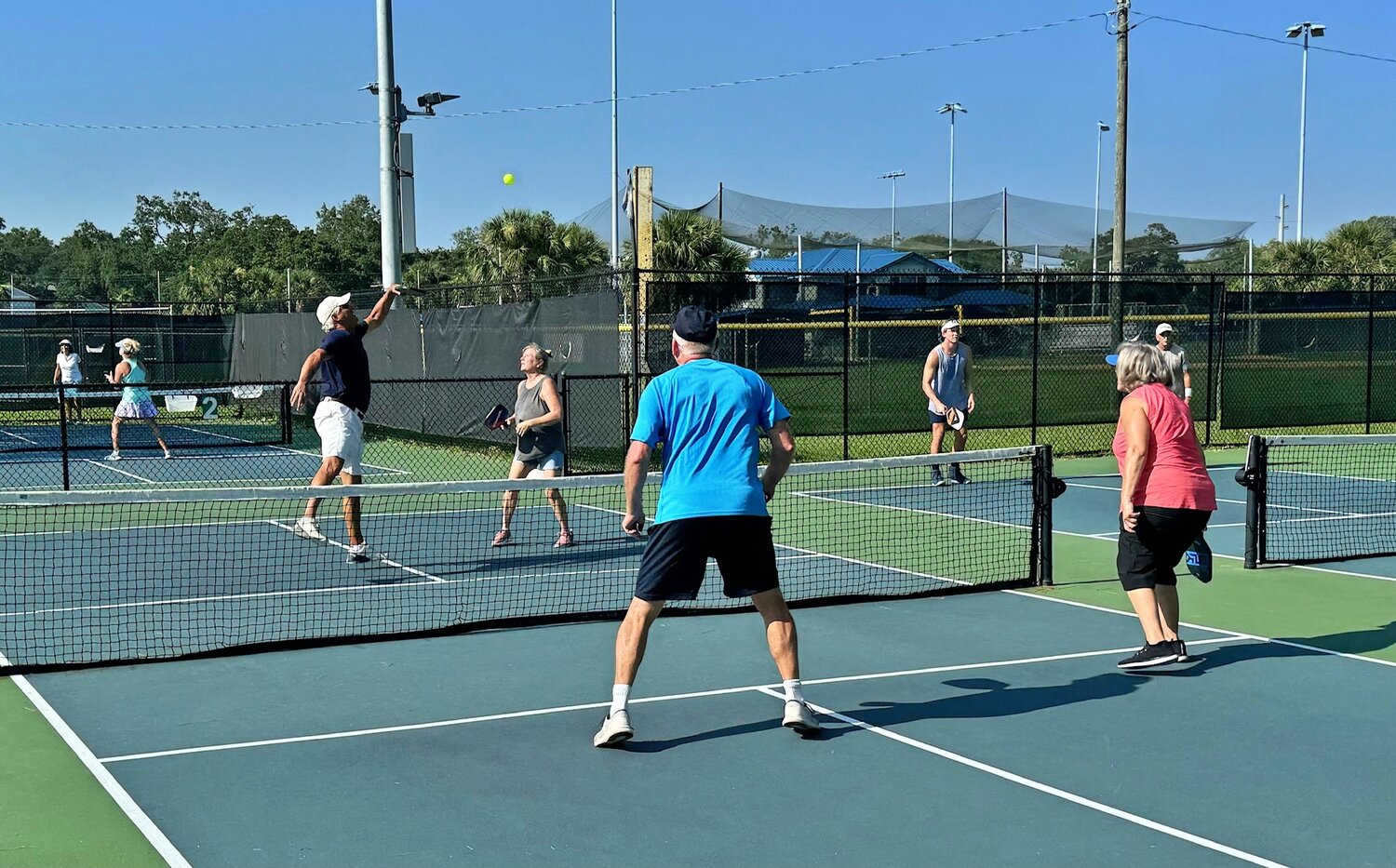Pickleball, the Easier Game – And an Easy Way to Get Hurt, Too
Like many Americans, Debra King, 64, discovered the joys of pickleball after retiring. King, however, is also part of the growing number of pickleball players who have experienced the downside of the popular sport — injury.
A retired real estate professional who lives in Fernandina Beach, King now approaches pickleball with a new respect for the game’s physical demands.
“I’m an athlete junkie,” says King, who has lifted weights, taught aerobics and played multiple sports. She was an avid golfer before a back injury made that activity difficult. As a retiree, she says, “I was a bit hesitant about playing court sports because I didn’t want a knee injury. But then pickleball came into play. It seemed like a good sport to replace golf. It had that group camaraderie I enjoy, hand-eye coordination, and it was supposed to be great for retirees.”
Pickleball participation has grown significantly in the United States over the past decade. The Sports and Fitness Industry Association estimates about 1.4 million Americans are regular players (meaning they play eight or more times a year). Pickleball participation has grown by more than 11% per year over the past five years.
However, recent studies show a corresponding surge in injuries. From 2002 to 2022, there was a 90-fold increase in fractures related to pickleball, according to data presented in February at the annual meeting of the American Academy of Orthopaedic Surgeons (AAOS). Researchers used a Consumer Product and Safety Commission database to explore pickleball injuries. They found that while men are more likely to suffer injuries requiring hospital admission, the most common pickleball injury was a fracture to the upper extremity among women ages 65 and older who fell.
“The number of people participating in the sport is increasing,” says Liam Globensky, a physical therapist at Brooks Rehabilitation in Fernandina Beach and an American Physical Therapy Association Accredited Clinical Instructor. “With the growth of any sport, as more people begin to play, the likelihood of bumps and bruises will likely rise.”
The problem is that people tend to think pickleball is relatively safe because it’s lower impact than tennis, experts in sports medicine say. While participants may think of the sport as recreational, games can become intense, especially among experienced and competitive players. Oftentimes, injuries occur during competitive exertion, Globensky says.
“Habits like reaching overhead, trying to put some mustard on an overhead when you haven’t done that in a while or attempting to stop on a dime and spin can increase your risk of potential injury,” he says.
Some injuries occur because people jump into the sport without spending some time conditioning their bodies for a new activity.
“There is always an increased risk of injury if you try to go from a very low level of activity to one of high intensity,” Globensky says. “It’s best to start with a gradual increase in intensity and skill level over an appropriate period of time.”
However, the risk of injury varies among pickleball players, Globensky says. “It is solely dependent on the individual, their own history, and their own skill level and physical capabilities.”
Strains, sprains, fractures and bruising were the most common injuries cited in a study published in 2021 in the journal Injury Epidemiology. The study found men were much more likely than women to suffer a sprain or strain while women were much more likely to fracture a bone.
Too much pickleball can also lead to problems. Overuse injuries are common among pickleball players, according to the American Medical Association (AMA). Shoulder, elbow and knee joints can become inflamed. Medical professionals have adopted the term “pickleball elbow” to explain the inflammation of one of the large tendons on the outside of the elbow.
Falls are an inherent risk to the sport, studies show. A study published in 2023 from researchers at Thomas Jefferson University in Philadelphia found about 41% of pickleball injuries were caused by falling or diving for a shot while about 5% of injuries were attributed to overuse.
King, who has been playing pickleball three times a week for about six years, says she did not anticipate how the fun and vigor of a competitive game could lead to injury.
“You tend to forget about the actual risk involved,” she says. “You get caught up in the game. I am extremely competitive and an athlete all my life. The age issue just goes away. It’s all about winning.”
On New Year’s Day, 2022, she was in a “heated game” when she ran backwards to retrieve a shot that was over her head.
“I was bound and determined to get the shot,” she says. “I ran backwards and lost my balance. I fell and broke my wrist. It was never brought to my attention not to run backwards, but I should have known better.”
King suffered a severe break that required surgery, a plate and screws, and took several months to heal.
“Age is a factor,” King says of the injury risk among older adults. “Our balance is not as good as it used to be. We think we can do the things we did in our 20s and 30s, and we can’t.”
Most pickleball injuries are minor and treatable, however, and players return to the beloved game. Globensky recommends seeing a health professional promptly to address any injury,
“As soon as you notice considerable discomfort over two to three days that isn’t typical soreness, consider a visit to an orthopedic physical therapist,” he says. “Too often, I will see someone who puts off some discomfort for weeks to months, attempting to play through it. They end up participating in a one-month to two-month therapy, when it could’ve been a quick fix early on.”
King returned to pickleball — but not without some bad luck.
“No sooner than I returned, my first game, I ran backwards again, and I fell again and hit my head very hard,” she says. “I had a lump that said: ‘You will never run backward again.’ Turn around, run to where the ball will be and then turn around.”
A few injuries won’t deter her, however. “It’s better to be out there doing something,” King says.
To be sure, the sport confers many benefits, Globensky notes. In addition to the benefits of socialization, pickleball players burn calories and strengthen their bones and muscles.
“Participation in a sport, like pickleball, is incredibly rewarding,” he says, “Not just for orthopedic health, but for cardiovascular and social health as well. When it feels that we have to give up more and more due to our aches and pains, I’m here to say that there are resources that can assist in keeping and promoting a more active lifestyle. A bump or bruise shouldn’t keep you from participation.”
To continue to enjoy the game, experts from the AMA suggest several injury-prevention strategies. Anyone new to pickleball should check with their physician first, especially people who have been inactive and have heart or lung conditions. If you have preexisting arthritis, start slowly and gauge how much activity you can tolerate. Stop if you feel sudden pain; don’t try to push through it.
Start and end your pickleball games with stretching, AMA experts recommend. Hydrate before, during and after games. Finally, a few lessons from a pickleball coach or expert can go a long way to help you adopt proper techniques to avoid injury.








